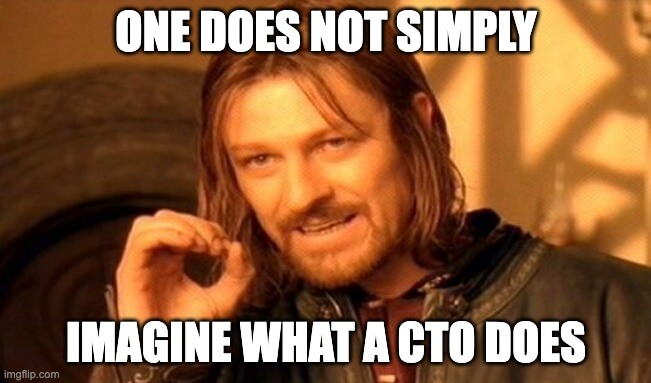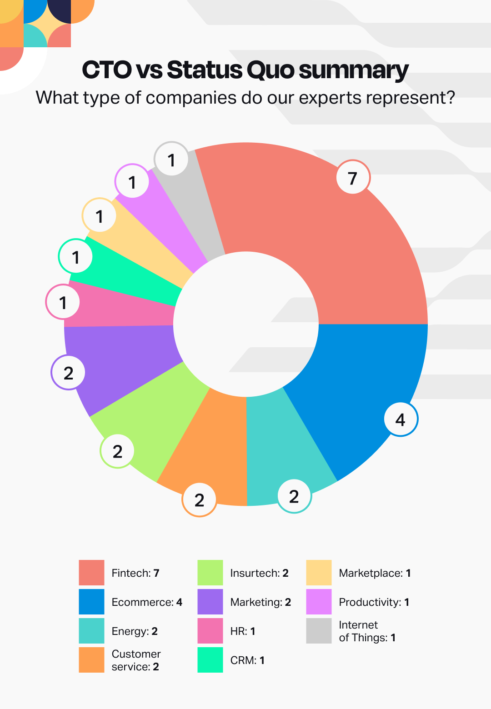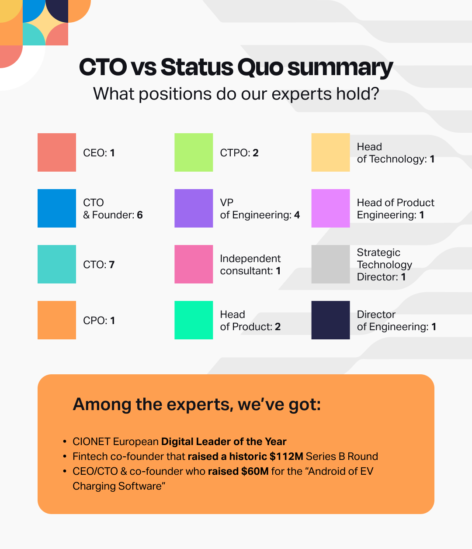17 September 2024
The role of a CTO today – 26 insights from 26 C-level experts we talked to in person
What does a CTO really do? No, really – can you give a one-sentence answer that isn’t as generalized as it is meaningless? We interviewed 26 CTOs, CPOs, and VPs of technology from the Nordics, Netherlands, and UK to answer this broad question in the most practical way. They helped us determine 3 key jobs of a CTO and tons of (but at least 26!) practical ways in which they pursue them every day. These insights combine in a one-of-a-kind journey through the mind of a modern CTO.
Hi there! Did you come here to get answers to questions like:
- how one Chief Technology Officer spots hirees “with an urge to build”,
- why another CTO encourages his technology teams to speak with customers directly,
- why do companies miss out on so much creativity by blocking divergent thinking,
- can you really replace all processes with systems (and what are they anyway?!),
- or why some Chief Technology Officers insist that they have nothing to do with James Bond?
We’ll have our experts tackle them all, but let’s first answer another one that contains all of the above and more: What is the role of a CTO today?
A fireman extinguishes a fire or climbs a ladder to save a naughty cat from a big tree. A baker bakes the same bread every day, taking it out of the oven and onto a bakery trolley to cool off.
But can you visualize what a CTO does the same way?

You can google anything, including “the role of a CTO,” but if you want a job description that is more concrete than:
”The CTO serves as a strategic leader for the IT department.”
, you’re probably going to need to redo your search many times.
We’ve talked to enough technology leaders to know that being a CTO means something different to everyone. No two technical companies have the exact same problem, and even the same company has completely different technical needs at different stages of its growth.
Speaking from his own experience, The Software House’s own CTO, Marek Gajda, also admits that his role as a CTO was subject to constant changes:
While the title remained the same, my responsibilities shifted dramatically over time. Early on, I was deeply involved as a tech leader, then moved into project management, followed by a focus on operational efficiency.
Now, my primary task is creating the best structures to ensure scalability and innovation. The role of a CTO is never static – it’s a constant evolution.
We’ve determined that three high-level roles stand out in the CTO’s day schedule today. These are:
- to increase the efficiency of the organization,
- to help the company grow and sustain business growth through technology,
- to reach personal goals and improve as a person & manager.
We suspect that these areas don’t depend on technology trends so much and won’t go away quickly. But how CTOs navigate them changes all the time. Luckily, the CTOs we talked to shared many of their navigation directions with us.
CTO’s role no. 1 – to increase the efficiency of the organization
Looking for problem-solvers
To kick off the discussion about an organization’s efficiency, the CTO of Smartum, Mika Peuralahti, shared his thoughts about… a blue button:
“Previously, our backlog tended to be just a collection of features. I remember questioning the team, ‘Why are we working on this feature, like a “blue button”?’ The immediate answer would be, ‘Because that’s what the customer wants.’”
When he discussed this issue with his developers, it turned out there was no need to add a new button, and the purpose it would serve could be provided less redundantly. Mika learned about it because he let his developers speak their minds about the product as a whole rather than isolated features. He let them be problem-solvers.
If you want your team to have more natural problem-solvers, you may want to follow the advice of another of our guests, Mediatool’s CTO, Ludwig Magnusson:
“Today, I’m looking for people who love building all of these complex and difficult products while at the same time being able to talk about them in simple terms. This shows that they are having fun. Those are the hungry people, the people I want to do stuff with.”
This is Ludwig’s recipe for hiring developers who have the same urge to build as he’s had over the years. This urge allowed him to transition from a purely technical role into a product-minded CTO.
The push towards bold, creative, and self-reliant developers doesn’t end on the individual level. The CTO of Northfork, Majid Garmaroudi, believes in self-managed teams that don’t need much supervision to determine the best solution to a problem. But to foster such teams, some organizations need some soul-searching:
“Large organizations, in particular, need to do a lot of cultural changes. The top management needs to accept the idea of delegating power, not just tasks, and providing the trust their workers need.”
Contractbook’s VP of Engineering, Wojciech Zawistowski, expanded on that when talking about product-oriented development. He said that developers need more than just an interest in the product – they also need more contact with the customer. Providing them with that contact is yet another step towards self-managed and product-oriented development.
“At Contractbook, developers don’t contact a random customer to ask about a feature. To get accurate insights, they contact a particular customer who is a good fit and interested in a given feature. To find them, developers collaborate with the customer success team, which is in close relationships with customers.”
To learn more about this holistic product-oriented management style, Wojciech recommended reading Marty Cagan’s Inspired – and he wasn’t the only one.
But even when you know how to hire creative people, you should still promote creativity in your organization. Martin Mazur has some thoughts about it:
“If you look at math classes in primary school, you aren’t just expected to give the right answer but to arrive at the answer in a predetermined manner. That becomes ingrained in all our minds as we age.”
He counters it by fostering divergent thinking. It’s about inviting your team for sessions of unrestrained creativity, unbounded by reason and practical concerns. The time for “Hold on. We can’t do that!” will surely come later. For now, tell me what you would do if you had unlimited time and resources!

Bringing some discipline into the creative mess
Once the period of unbounded creativity is over, you’ll need to restore order somehow. The co-founder and CTO of Payhawk, Boyko Karadzhov, told us about his company’s internal operating framework. It allows every employee to track the openly available outputs of meetings, including those from different departments. This is how creative ideas flow between departments. From there, there’s just one more step towards cross-functional product-oriented teams.
“PayhawkOS lists meetings, processes, documentation, strategic decisions, and what’s in the internal system.”
The thing about creativity and good ideas is that they come and go seemingly at random. It would be nice if you had a roadmap that was flexible enough to accommodate new great ideas along the way and solid enough to know where you were going. Gijs Hendrix shared his solution to that problem:
“The answer I found is the now-next-later roadmap. As the name says, it only specifies what to do now and in the immediate future. It may also include a list of things on our radar that will be specified later. These items should only have vague, vague timeline commitments.”
So dream on and plan out, but make it less explicit the further you go!
Building bridges in the organization
But you’re not going to be able to turn each creative idea into reality. Remco Magielse, the product face of CM.com’s product-development tandem, believes that one way to find those with the best potential is to look at the product from a technological perspective:
“A trend that you definitely see today is that product and tech are coming closer together – to the point that you often see one person doing both as a CTPO. This shows how much we move towards technology-based products in which technology and products are deeply interwoven.”
His technological counterpart Bas Gijzen agrees but points out that both the product and technological side need to understand each other if they are to make optimal decisions about what goes on into the roadmap:
“I think that the main job of tech and product people is to support each other with the knowledge necessary to understand the trade-offs and make the best decisions for the sake of everyone.”
Handling trade-offs in increasingly cross-functional organizations really is a must. The objectives of different departments inevitably clash, but they all need to move towards the same overarching business goals. Sudhan Dhayalan, Head of Product Engineering, revolves these conflicts like this:
“At the beginning of every quarter, we come together as a company and as teams to decide our cross-project dependencies. If our project or goal clashes or overlaps with another team’s, the PMs take the responsibility to collaborate and come up with a plan for moving forward.”
If you want to improve this cross-department collaboration, you may consider following the example of Huss El-Sheikh, the CTO and Founder of 9fin:
“Then, over the weeks or months, there is a series of introductory talks for newcomers. One meeting is with the product team to show how we build; another one is with sales to explain our commercial model and the customer types.”
If you want different departments to cooperate successfully and understand each other’s problems and aspirations, they need a common core – one foundation of knowledge upon which they can build their relationships in the organization.

CTO’s role no. 2 – to help a company sustain growth
When the culture supports efficient development, the organization will grow. However, when the size and scope of the business increase, the culture will truly be put to the test. Is the organization scalable? Can it navigate the internal and external changes? Our guests had a lot to say about how they help manage growth.
Scaling your teams
For example, bad team structure may not be an issue early, but not thinking about this subject may come back to haunt you when your ranks swell. Brite Payments’ CTO Harald Walden has fostered a product-based rather than technology-based division:
“At Brite, groups of people are doing similar things in their own smaller teams. Some people work on incoming payments, while others work on business-to-consumer payments – sometimes called payouts or withdrawals. […] We resisted splitting into a frontend and backend team because our work is very backend-heavy.”
Delivery speed may also suffer as you grow. It may be a case of stiff processes that don’t adhere to the needs of growing teams, requiring too much overhead or management. In response to this, Tibber’s CTO Richard Eklund pushes the concept of systems:
“A process to me is a stricter term in the sense that you go through a few stages in a pre-described fashion. Systems provide a familiar space. You use them to help you make an optimal decision. They restrict you a little, but you still have freedom within some bounds.”
Getting better, sustainably
When you grow, you may acquire other businesses instead of developing new features. It may be an efficient way to grow under some conditions. According to the CTPO and co-founder of Dixa Jacob Nederby Nielsen, success in onboarding the team from an acquired organization has much to do with your culture.
“If it’s forgiving and understanding, everything will go smoother, and new teammates will be outspoken and proactive in resolving issues. If that established culture is toxic and accusatory, newcomers will stay quiet. You will struggle to maximize collaboration, and you won’t even know why.”
It follows that before you acquire another company, you should ensure that your organization welcomes creative minds.
Just like your company’s culture can decide if your new employees adapt quickly, the founder and CTO of Picnic, Daniel Gebler, makes it clear that your observability capabilities will decide how fast you’ll be able to learn and make improvements to keep your growing organization competitive:
“But what’s even more critical is that you can only learn from a product if it is stable for an extended amount of time. Only that gives you enough uptime of good quality. Hence, the second reason is to enable fast feedback loops.”
When you have these fast feedback loops, you can do much more than just fix errors – you’ll be able to prevent them by determining countless predictors of future problems.

However, sustainable growth is not just about big high-level strategies but also your daily attitude. As a manager, Ben Brown scaled engineering from 10 to over 100 employees at three companies. The CTO of Flock believes that companies often prioritize speed too much at an operational level to the detriment of their team’s growth:
“For instance, an urgent requirement comes in. What’s the quickest way to get that delivered? You assign it to the most experienced person because they can quickly grasp the code.
But if we do this every time, how will anyone else on the team ever learn to work with the requirements?”
Some food for thought, isn’t it?
When you ensure everyone gets their share of stimulating challenges, you can continue with your roadmap. Anthony Oduu, the co-founder and CTO/CPO of Verto, has three rules that ensure that each initiative supports the overall commercial strategy, even as it evolves:
1. “Any new initiative must increase operational efficiency.”
2. “The initiative must serve enterprise customers that we’d like to sign up more of.”
3. “New development projects must clearly impact revenue, which is our North Star metric.”
While you adjust your roadmap, ensure you don’t cause any development bottlenecks. Daniella Rhodes Lorenzo of Toqio believes that these often result from added requirements that weren’t identified in the planning phase:
“When you usually define a requirement from the product side, the tech team is involved. The infrastructure team might not be involved in product development conversations and be kept in the background, like a shadow. There’s a high chance someone forgets to list tasks for them.”
This plays to the more significant point that when your developers think they aren’t informed enough, their motivation will likely suffer. Sue Lie, the CTO at SwipeGuide, believes that no matter what, the conversation about new challenges should start with answering the question, Why:
“Your team needs to believe that what you want to achieve makes sense to them personally. There’s a nice alignment model from Simon Sinek that I like using: start with ‘Why.’ You will get resistance if you start with ‘What’ or ‘How.’.”
Keeping tabs on the technology – the basics and the cutting-edge
As your team grows, so does your infrastructure – in volume, data, and sheer complexity. If you want to keep your cloud costs under control while remaining flexible, Insify’s VP of Engineering Mark Yudin has advice on that, along with some words of encouragement:
“You need to think about re-architecting as you go through further stages of growth.
[…] Finding the sweet spot of optimization is hard. But simply doing ROI calculations puts you ahead of the curve. Many companies today either over-optimize because they think they will grow 1000 times, or they don’t put any thought into this at all.”
But what if not the architecture but your processes prove insufficient to handle traffic, customer onboarding, or any other challenge of fast growth?
In that case, automation, even AI automation, can be the answer to improve scalability. But how do you convince stakeholders to step into unfamiliar territory? The VP of Engineering at Trengo, Alex de Groot, has the answer:
“If you want to augment something, you take an existing business process and optimize some parts of it with, in this case, AI. Then, you set clear outcome-driven KPIs that are easy to understand for stakeholders.”
Don’t dwell on technicalities – that’s what you will do when they give you that green light!
Matija Cukac of Relay42 echoed this sentiment and added another rule to follow when you implement AI solutions:
“Accuracy is crucial. If your success with AI-based prediction is very high, you can move to the next stage. But if it’s low and you still move forward, you’re adding variables based on faulty data, which will cause more failures.”
So don’t go all out. Start by automating a single little task and move on to bigger tasks and whole features based on the data you collect. You’re not going to become an AI powerhouse overnight – patience is the key!

CTO’s role no. 3 – to improve as a manager and person
As CTOs shape their organization’s culture for improved efficiency and protect it from the dangers of accelerated growth, they can’t forget about themselves. In fact, everything that our experts said seems to suggest that their own attitude is key in making positive changes across their organization.
A CTO with trust issues will not successfully foster self-managed teams. A CTO with only technical skills may struggle to think about the product in a more business-oriented way. Their fears and reservations will leave a mark on the rest of his crew. To change that, they need to better themselves. Our guests showed that the means to do that are both outside and within them.
Graduating from the role of a CTO
Penneo’s Hans J Skovgaard told us that if you want to move beyond CTO into the CTPO role, you need to focus even more on your ability to influence people:
“At a certain point in time, I realized that being good at technology is what’s required to be a CTO for a small team. But if you want to move higher, you need something more. You need the ability to get a team of 20-30 to produce good stuff efficiently.
Then I decided that if I wanted to go that way, I needed a good management education. My MBA education in Switzerland was eye-opening. When I went back, I started getting CTPO roles because then I had both an understanding of technology and business.”
If you want to go even further and transition from CTO to CEO, you need the ability to inspire not just a single team but the entire organization. You may try to learn to be a better storyteller. That’s what Casper Rasmussen, the CTO and CEO of Monta, does:
“The CEO’s job is to convince users, team members, and investors to believe in their vision and join them. Then, they must keep people engaged throughout the journey.
Fundraising is about telling your story in a very bold way. It’s also about creating a viable business model, which involves the thing you build and your potential markets or teams. You need to be able to spot business opportunities and make a lot of educated guesses about the future.”
Staying humble
Echoing Casper’s advice as well as Sue Li’s words about first answering the question Why, the VP of Engineering at Habito Neil Mountford encourages you to be a servant leader:
“Employees aren’t just cogs in a machine. You need to help them understand and motivate them.
The other side of servant leadership is to help the team understand how we get there. I have this new feature that needs to be delivered. What do we need? How long will it take? What are the blockers we’ll most likely see?”
To be that kind of servant leader, to restrain yourself from using your position to impose your will upon others, it takes a lot of humility. At least, that’s what Hiber’s Bart Oor seems to believe. He has a thought experiment for you:
“You are a part of a new team. You don’t know anyone else on that team yet. Someone comes in and says: “Bart is now going to be the leader.” That creates an interesting dynamic right from the start. The person who is appointed as a leader feels automatically enlarged. At the same time, the rest of the group decides to listen to and follow Bart despite not knowing yet what his or anyone else’s capabilities are.”
If you’ve been a fan of a top-down approach until now, it may take time to convince yourself that your opinion is not automatically better just because you are a CTO. But perhaps doing so is worth the mental effort? Maybe, like Mika said, it will make your people feel like they own their work and serve to motivate them.
“If everyone takes part in the ownership of the idea from the beginning, they will be more motivated and feel better about it.”

The role of a CTO today – 3 big challenges, 8 practice-proven solutions
The solutions that CTOs employ to hone their three leadership skills are more diverse than ever.
With the continuous rise of cloud computing and emerging technologies in the AI area, the prominent role of technology in an organization’s business model continues to increase. On the other hand, companies in the tech industry push for product-oriented development, which compels CTOs to obtain many business skills that would not be considered traditional in their skill set.
In response to this, CTOs:
- find ways to hire and foster developers who want to take an active role in solving user problems and developing new business models,
- find new methods of structuring and aligning technology development without restraining that culture of creativity and self-reliance,
- push themselves and their developers to collaborate with other departments and customers,
- manage their technology strategy and teams in a way that scales,
- use data and processes to help everyone improve daily,
- gain the skills traditionally associated with CPOs and CEOs and even transition to these roles,
- help their developers be the best version of themselves without imposing their will on them.
We’re sure that you share many of these sentiments about the role of tech leaders today, but if you were surprised by some opinions, that’s even better. That means that you’re still passionate about your company’s technology strategy and the impact new technologies have on the business.
If you want to dig deeper into some of the insights we presented here, follow one of the links above and read a full interview.
Better yet, check out the CTO vs. Status Quo’s homepage.
It has all the interviews and more information about the series.


